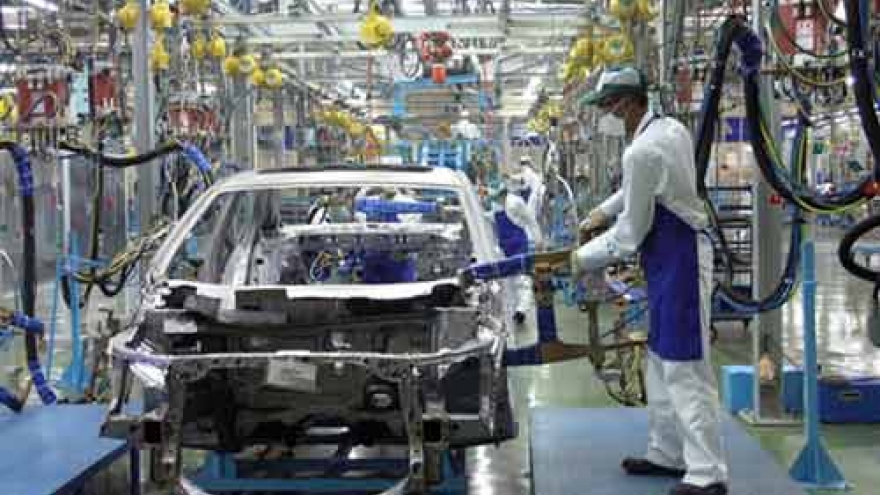For him, not upgrading was unthinkable, despite higher prices.
“Car prices have increased due to many reasons like higher foreign exchange rates, import costs and taxes. They have never fallen,” Ha said, inspecting a new Lexus RX 350.
“So I could not wait for lower prices to buy it.”
With the rapid expansion of a young, style-conscious middle class after many years of economic growth of over 5%, demand for automobiles has surged.
The recent jump in prices of imported cars due to a new methodology for calculating special consumption tax is unlikely to put the brakes on the automobile market.
From January 1 the tax is calculated on an imported car’s retail price and no longer on the cost, insurance freight (CIF) price before the addition of duties and markups.
The change has reportedly forced auto importers to increase their prices by 2%-13%.
As a member of the World Trade Organization since 2007, Vietnam cannot directly raise duties on imported cars to the benefit of local companies, thus the special consumption tax.
In a car showroom filled with latest BMW and Audi models in Hanoi’s Thanh Xuan Street, Nguyen Son Tung, the manager said: “The price increase is insignificant compared with the value of a car. Customers will accept even higher prices.”
He said sales had not changed much since the new rule came into effect, and customers still pay deposits in advance and wait for two to five months to get their cars.
The prices would rise further when the special consumption tax on cars with engines of more than three liters, including motor homes, is hiked to 150% in July. The tax is now 15%-60% depending on the number of seats and engine size.
Most of these big cars are made by Japanese and European luxury brands.
But the new taxes seem unlikely to dampen growth in either the mid-market or luxury segment. Last year Mercedes-Benz, Lexus and BMW all reported strong growth after selling in excess of 6,000 units.
Local consumers are already used to paying high prices for vehicles, which are on average up to 20% more expensive than elsewhere in Southeast Asia.
The number of households in Vietnam with assets of US$100,000 to US$2 million would soon be among the fastest growing in the world, Reuters quoted the Economist Intelligence Unit as saying, fuelling luxury vehicles sales. Vietnam’s GDP per capita reached US$2,109 in 2015, up from US$2,052 in the previous year, according to the World Bank.
Porsche Cayennes and Bentleys can nowadays be seen jostling with budget cars and scooters on the chaotic streets of Hanoi and Ho Chi Minh City.
For many Vietnamese, a car is not a vehicle but a means to show their success and social status.
A Toyota Vietnam spokesperson said there is always a waiting list of dozens of people for imported Lexus cars.
More than half the cars sold in the country last year were imported at nearly US$2.96 billion, a 88% rise from 2014. India topped the list of exporters to Vietnam, followed by China, the Republic of Korea, and Thailand.
Interest
Vietnam is enjoying a surge in interest among automobile importers as sales saw a record growth of 55% last year, following growths of 35% and 23% the previous two years.
Sales growth will continue to be strong this year, albeit quite a bit slower, according to industry insiders.
Major producers and importers like Ford Vietnam, GM Vietnam and Truong Hai Auto Corporation estimate overall sales to grow at around 30%, saying the economy would continue to grow strongly, boosting demand.
Yoshihisa Maruta, chairman of the Vietnam Automobile Manufacturers Association, said on the other hand its members only expect a rise of 10%.
Bui Kim Pha, deputy CEO of Truong Hai Auto Corporation, said the market is stabilizing and so its growth would not be as high as last year when it saw a six-year record growth in sales to nearly 245,000 units.
Mercedes-Benz Vietnam plans to invest an additional EUR11 million (US$12.2 million) this year. The money would be used to set up two new assembly lines, Dirk Adelmann, sales director of the company, said.
The firm sold 3,600 units last year, its 20th year in Vietnam. A 50% growth meant Vietnam was one of Mercedes-Benz’s five fastest growing markets in the world, Adelmann said.
Rolls-Royce and Bentley recently opened their first dealerships in Vietnam.
The abolition of import tariffs on vehicles as part of the ASEAN Trade in Goods Agreement also makes the market attractive.
The tariff was reduced to 40% in January from 50% previously, and will further fall to 30% next year.
Import duties on cars from ASEAN member countries will go in January 2018.
While importers are eagerly waiting for the tax abolition, domestic auto manufacturers are worried about competing with imports. The automobile industry has been focusing mainly on assembling since it was established two decades ago. Vietnam imports most components or vehicles in knocked-down form, which are subject to tariffs of 10%-30%.
This means cars cost that much more to make in Vietnam than in other ASEAN countries, according to the Vietnam Automobile Manufacturers Association.




